 W
WThe Book of Genesis, the first book of the Hebrew Bible and the Christian Old Testament, is an account of the creation of the world, the early history of humanity, Israel's ancestors, and the origins of the Jewish people. Its Hebrew name is the same as its first word, Bereshit.
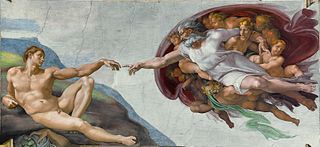 W
WAllegorical interpretations of Genesis are readings of the biblical Book of Genesis that treat elements of the narrative as symbols or types, rather than viewing them literally as recording historical events. Either way, Judaism and most sects of Christianity treat Genesis as canonical scripture, and believers generally regard it as having spiritual significance.
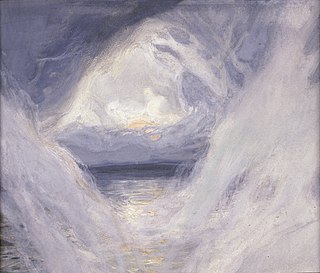 W
WThe antediluvian period is the time period chronicled in the Bible between the fall of humans and the Genesis flood narrative in the biblical cosmology. The term was coined by Thomas Browne. The narrative takes up chapters 1–6 of the Book of Genesis. The term found its way into early geology and science until the late Victorian era. Colloquially, the term is used to refer to any ancient and murky period.
 W
WOn Christmas Eve, December 24, 1968, in the most watched television broadcast at the time, the crew of Apollo 8 read from the Book of Genesis as they orbited the Moon. Astronauts Bill Anders, Jim Lovell, and Frank Borman, the first humans to travel to the Moon, recited verses 1 through 10 of the Genesis creation narrative from the King James Bible. Anders read verses 1–4, Lovell verses 5–8, and Borman read verses 9 and 10.
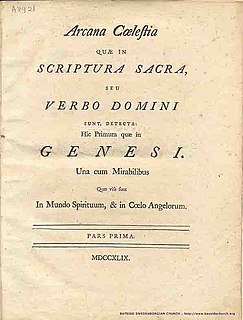 W
WThe Arcana Cœlestia, quae in Scriptura Sacra seu Verbo Domini sunt, detecta, usually abbreviated as Arcana Cœlestia or under its Latin variant, Arcana Cælestia, is the first and largest work published by Emanuel Swedenborg in his theological period. It was written and published in Neo-Latin, in eight volumes, one volume per year, from 1749 to 1756.
 W
WArpachshad, alternatively spelled Arphaxad or Arphacsad, is one of the postdiluvian men in the Shem–Terah genealogy. The name is recorded in the Book of Genesis in the Hebrew Bible and subsequently copied in different biblical books, including the Gospel of Luke in the New Testament.
 W
WThe Bible: In the Beginning... is a 1966 American-Italian religious epic film produced by Dino De Laurentiis and directed by John Huston. It recounts the first 22 chapters of the biblical Book of Genesis, covering the stories from Adam and Eve to the binding of Isaac. Released by 20th Century Fox, the film was photographed by Giuseppe Rotunno, and Ernst Haas shot the opening creation sequence, in Dimension 150, a variant of the 70mm Todd-AO format. It stars Michael Parks as Adam, Ulla Bergryd as Eve, Richard Harris as Cain, John Huston as Noah, Stephen Boyd as Nimrod, George C. Scott as Abraham, Ava Gardner as Sarah, and Peter O'Toole as the Three Angels.
 W
WThe Casluhim or Casluhites were an ancient Egyptian people mentioned in the Bible and related literature.
 W
WThe Cave of the Patriarchs or Tomb of the Patriarchs, known to Jews as the Cave of Machpelah and to Muslims as the Sanctuary of Abraham, is a series of caves located in the heart of the Old City of Hebron in the southern West Bank. According to the Abrahamic religions, the cave and adjoining field were purchased by Abraham as a burial plot.
 W
WIn the Hebrew Bible, the coat of many colors is the name for the garment that Joseph owned, which was given to him by his father Jacob.
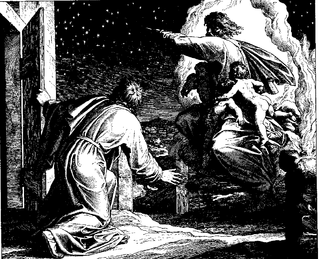 W
WAccording to the Hebrew Bible, the covenant of the pieces or covenant between the parts was an event in which God revealed himself to Abraham and made a covenant with him, in which God announced to Abraham that his descendants would eventually inherit the Land of Israel. This was the first of a series of covenants made between God and the biblical patriarchs.
 W
WThe Genesis creation narrative is the creation myth of both Judaism and Christianity. The narrative is made up of two stories, roughly equivalent to the first two chapters of the Book of Genesis. In the first, Elohim creates the heavens and the Earth in six days, then rests on, blesses and sanctifies the seventh. In the second story, God, now referred to by the personal name Yahweh, creates Adam, the first man, from dust and places him in the Garden of Eden, where he is given dominion over the animals. Eve, the first woman, is created from Adam and as his companion.
 W
WIn Judaism, Christianity, and some other Abrahamic religions, the cultural mandate is the divine injunction found in Genesis 1:28, in which God, after having created the world and all in it, ascribes to humankind the tasks of filling, subduing, and ruling over the earth. The cultural mandate includes the sentence "Be fruitful and multiply and fill the Earth." The cultural mandate is given to Adam and Eve.
 W
WThe curse of Cain and the mark of Cain are phrases that originated in the story of Adam and Eve in the Hebrew Bible. In the stories, if someone did something to harm Cain, the damage would come back sevenfold. Some interpretations view this as a physical mark, whereas other interpretations see the "mark" as a sign, and not as a physical mark on Cain himself. The King James Version of the Bible reads "set a mark upon Cain."
 W
WThe curse of Ham occurs in the Book of Genesis, imposed by the patriarch Noah. It occurs in the context of Noah's drunkenness and is provoked by a shameful act perpetrated by Noah's son Ham, who "saw the nakedness of his father". The exact nature of Ham's transgression and the reason Noah cursed Canaan when Ham had sinned have been debated for over 2,000 years.
 W
WThe fall of man, or the fall, is a term used in Christianity to describe the transition of the first man and woman from a state of innocent obedience to God to a state of guilty disobedience. The doctrine of the fall comes from a biblical interpretation of Genesis chapter 3. At first, Adam and Eve lived with God in the Garden of Eden, but the serpent tempted them into eating the fruit from the tree of knowledge of good and evil, which God had forbidden. After doing so, they became ashamed of their nakedness and God expelled them from the Garden to prevent them from eating from the tree of life and becoming immortal.
 W
WThe expression "fig leaf" is widely used figuratively to convey the covering up of an act or an object that is embarrassing or distasteful with something of innocuous appearance, a metaphorical reference to the Biblical Book of Genesis in which Adam and Eve used fig leaves to cover their nudity after eating the forbidden fruit from the tree of the knowledge of good and evil. Some paintings and statues have the genitals of their subjects covered by a representation of an actual fig leaf or similar object, either as part of the work or added afterward for perceived modesty.
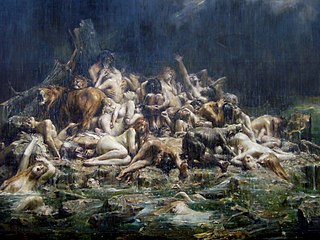 W
WThe Genesis flood narrative is a flood myth found in the Tanakh. The story tells of God's decision to return the Earth to its pre-creation state of watery chaos and then remake it in a reversal of creation. The narrative has very strong similarities to parts of the Epic of Gilgamesh which predates the Book of Genesis.
 W
WThe framework interpretation is a description of the structure of the first chapter of the Book of Genesis, the Genesis creation narrative. Biblical scholars and theologians present the structure as evidence that Gen. 1 presents a symbolic, rather than literal, presentation of creation.
 W
WThe Garden of Eden, also called the Terrestrial Paradise, or simply Paradise, is the biblical "Garden of God" described in the Book of Genesis and the Book of Ezekiel. Genesis 13:10 refers to the "garden of God", and the "trees of the garden" are mentioned in Ezekiel 31:9. The Book of Zechariah and the Book of Psalms also refer to trees and water, without explicitly mentioning Eden.
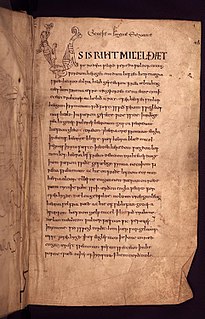 W
WGenesis A is an Old English poetic adaptation of the first half or so of the biblical book of Genesis. The poem is fused with a passage known today as Genesis B, translated and interpolated from the Old Saxon Genesis.
 W
WThe Genesis Apocryphon (1Q20), also called the Tales of the Patriarchs or the Apocalypse of Lamech and labeled 1QapGen, is one of the original seven Dead Sea Scrolls discovered in 1946 by Bedouin shepherds in Cave 1 near Qumran, a city in the northwest corner of the Dead Sea. Composed in Aramaic, it consists of four sheets of leather. Furthermore, it is the least well-preserved document of the original seven. The document records a pseudepigraphal conversation between the biblical figure Lamech, son of Methuselah, and his son, Noah, as well as first and third person narratives associated with Abraham. It is one of the nonbiblical texts found at Qumran. A range of compositional dates for the work have been suggested from the 3rd century BCE to 1st century CE. Palaeography and Carbon-14 dating were used to identify the age of the documents. It is 13 inches in length and 2.75 inches in width at its widest point in the middle.
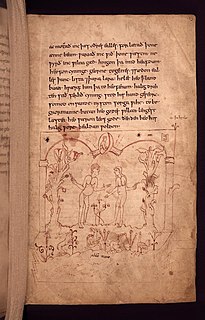 W
WGenesis B, also known as The Later Genesis, is a passage of Old English poetry describing the Fall of Satan and the Fall of Man, translated from an Old Saxon poem known as the Old Saxon Genesis. The passage known as Genesis B survives as an interpolation in a much longer Old English poem, the rest of which is known as Genesis A, which gives an otherwise fairly faithful translation of the biblical Book of Genesis. Genesis B comprises lines 235-851 of the whole poem.
 W
WGenesis Rabbah is a religious text from Judaism's classical period, probably written between 300 and 500 CE with some later additions. It is a midrash comprising a collection of ancient rabbinical homiletical interpretations of the Book of Genesis.
 W
WGihon is the name of the second river mentioned in the second chapter of the biblical Book of Genesis. The Gihon is mentioned as one of four rivers issuing out of the Garden of Eden that branched from a single river within the garden.
 W
WHaran is a place mentioned in the Hebrew Bible. Haran is almost universally identified with Harran, a city whose ruins lie within present-day Turkey. Haran first appears in the Book of Genesis as the home of Terah and his descendants, and as Abraham's temporary home. Later biblical passages list Haran among some cities and lands subjugated by Assyrian rulers and among Tyre's trading partners.
 W
WThe term Hexameron refers either to the genre of theological treatise that describes God's work on the six days of creation or to the six days of creation themselves. Most often these theological works take the form of commentaries on Genesis. As a genre, hexameral literature was popular in the early church and medieval periods. The word derives its name from the Greek roots hexa-, meaning "six", and hemer-, meaning "day".
 W
W"In the beginning" is an opening phrase first used in the Bible in Genesis 1:1. First referring to the beginning when the heavens and Earth were created and later commonly paralleled to Christians once again in John 1:1 as the "Word" being with God and being God during the beginning. Outside of the Bible, it is a common term in popular culture such as album titles and fiction titles.
 W
WJoseph's Granaries is a designation for the Egyptian pyramids often used by early travelers to the region. The notion of a granary being associated with the Hebrew patriarch Joseph derives from the account in Genesis 41, where "he gathered up all the food of the seven years when there was plenty in the land of Egypt, and stored up food in the cities ... And Joseph stored up grain in great abundance, like the sand of the sea, until he ceased to measure it, for it could not be measured". "So when the famine had spread over all the land, Joseph opened all the storehouses and sold to the Egyptians"(v. 56). Similarly, in the Quran: "(Joseph) said: 'Give me charge of the granaries (خَزَائِنِ) of the land. I shall husband them wisely'" (12:55). The designation was used throughout the Middle Ages and only really abated in the Renaissance when travel to the region became easier and closer investigation revealed the implausibility of the structures serving as storehouses for foodstuffs.
 W
W"Let there be light" is an English translation of the Hebrew יְהִי אוֹר found in Genesis 1:3 of the Torah, the first part of the Hebrew Bible. In Old Testament translations of the phrase, translations include the Greek phrase γενηθήτω φῶς and the Latin phrases fiat lux and lux sit.
 W
WMizpah is Hebrew for "watchtower". As mentioned in the biblical story of Jacob and Laban, making a pile of stones marked an agreement between two people, with God as their watching witness.
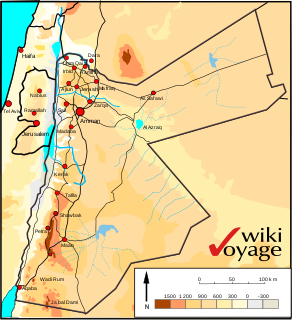 W
WMount Seir is the ancient and biblical name for a mountainous region stretching between the Dead Sea and the Gulf of Aqaba in the northwestern region of Edom and southeast of the Kingdom of Judah. It may also have marked the older historical limit of Ancient Egypt in Canaan. A place called "Seir, in the land of Shasu", thought to be near Petra, Jordan, is listed in the temple of Amenhotep III at Soleb.
 W
WNoah's Ark is the vessel in the Genesis flood narrative through which God spares Noah, his family, and examples of all the world's animals from a world-engulfing flood. The story in Genesis is repeated, with variations, in the Quran, where the Ark appears as Safina Nūḥ.
 W
WThe Hebrew Bible makes reference to a number of covenants with God (YHWH). The Noahic Covenant, which is between God and all living creatures, as well as a number of more specific covenants with individuals or groups. Biblical covenants include those with Abraham, the whole Israelite people, the Israelite priesthood, and the Davidic lineage of kings. In form and terminology, these covenants echo the kinds of treaty agreements in the surrounding ancient world.
 W
WPapyrus Oxyrhynchus 656 – is a Greek fragment of a Septuagint manuscript written on papyrus in codex form. This is a manuscript discovered at Oxyrhynchus, and it has been catalogued with number 656. Palaeographycally it is dated to late second century or early third century.
 W
WPapyrus Oxyrhynchus 1007 is a fragment of a Septuagint manuscript (LXX) written in two columns on a parchment codex. The manuscript was discovered in Oxyrhynchus, modern El-Bahnasa, Egypt. The manuscript has been palaeographically dated to the 3rd century CE.
 W
WIn the Hebrew Bible, Penuel is a place not far from Succoth, on the east of the Jordan River and south of the river Jabbok. It is also called Peniel "Face of God" by Jacob: It is because I saw God face to face, and yet my life was spared.
 W
WThe Pishon is one of four rivers mentioned in the Biblical Book of Genesis. In that passage, a source river flows out of Eden to water the Garden of Eden and from there divides into the four named rivers. The Pishon is described as encircling "the entire land of Havilah." Land of Pigmesh of Pishon River.
 W
WThe primeval history, the name given by biblical scholars to the first eleven chapters of the Book of Genesis, is a story of the first years of the world's existence.
 W
WThe Promised Land is the land which, according to the Tanakh, God promised and subsequently gave to Abraham and to his descendants. In modern contexts the phrase "Promised Land" expresses an image and idea related both to the restored Homeland for the Jewish people and to salvation and liberation.
 W
WIn Christian theology, the protoevangelium is God's statement to the Serpent in the Garden of Eden about how the seed of the woman would crush the serpent's head:"And I will put enmity between thee and the woman, and between thy seed and her seed; it shall bruise thy head, and thou shalt bruise his heel.""I will put enmities between thee and the woman, and thy seed and her seed: she shall crush thy head, and thou shalt lie in wait for her heel."
 W
WThe Battle of the Vale of Siddim, also often called the War of Nine Kings or the Slaughter of Chedorlaomer, was an event in the Hebrew Bible book of Genesis 14:1–17 that occurred in the days of Abram and Lot. The Vale of Siddim was the battleground for the cities of the Jordan River plain revolting against Mesopotamian rule.
 W
WSodom and Gomorrah were two cities mentioned in the Book of Genesis and throughout the Hebrew Bible, the New Testament, and in the deuterocanonical books, as well as in the Quran and the hadith.
 W
WTannin or Tunnanu was a sea monster in Canaanite and Hebrew mythology used as a symbol of chaos and evil.
 W
WTohu wa-bohu or Tohu va-Vohu, is a Biblical Hebrew phrase found in the Genesis creation narrative that describes the condition of the earth (eretz) immediately before the creation of light in Genesis 1:3.
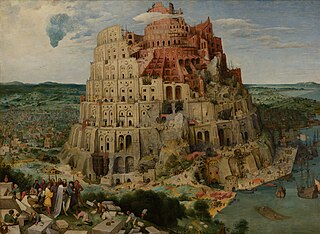 W
WThe Tower of Babel narrative in Genesis 11:1–9 is an origin myth meant to explain why the world's peoples speak different languages.